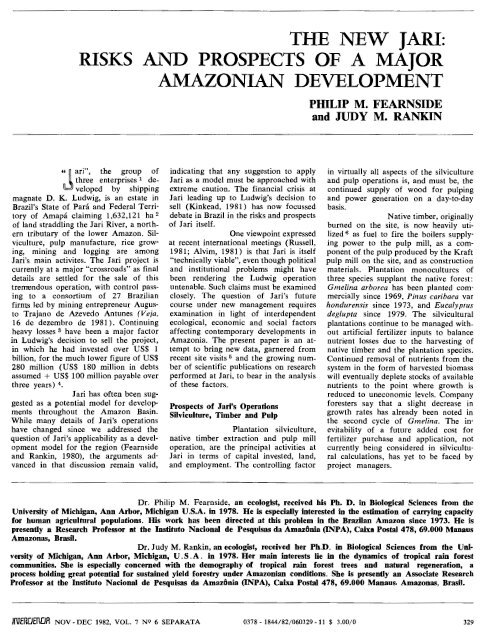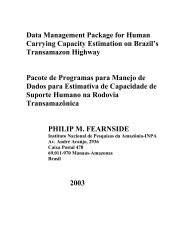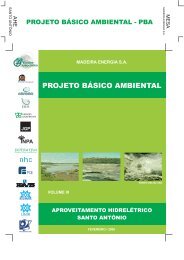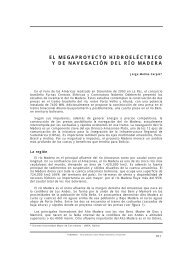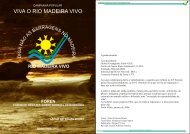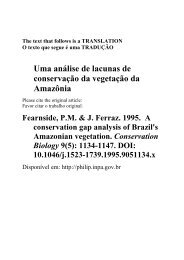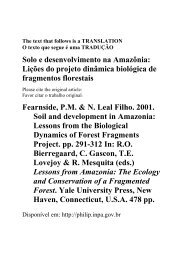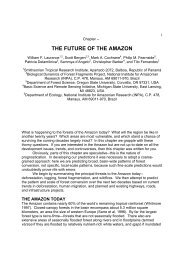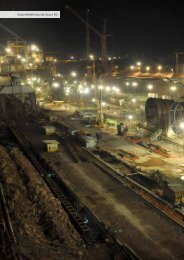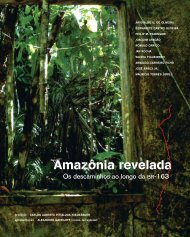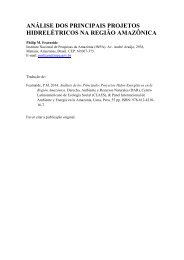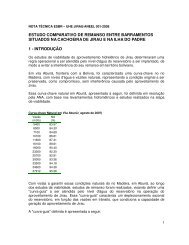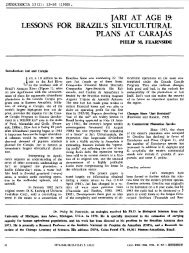the new jari - Philip M. Fearnside - Inpa
the new jari - Philip M. Fearnside - Inpa
the new jari - Philip M. Fearnside - Inpa
You also want an ePaper? Increase the reach of your titles
YUMPU automatically turns print PDFs into web optimized ePapers that Google loves.
Long term viability offertilizing Jari's plantations, as in manyof <strong>the</strong> forms of high input agriculturearound <strong>the</strong> world, is clouded by <strong>the</strong>diminishing global store of inexpensivenutrients. Projections of world trendsindicate both potash and phosphate rockbeing exhausted by <strong>the</strong> year 2061 (UnitedStates, Council on Environmental Qualityand Department of State, 1980). 11Utilization of low grade deposits afterthis date would result in dramatic priceincreases, as well as requiring presentlyunachieved technological breakthroughs.In addition to <strong>the</strong> costof suppliyng nutrients to <strong>the</strong> plantations,with or without better recycling in <strong>the</strong>system, plantation area will have to in·crease to compensate for wood presentlyderived from native forest. Establishing,maintaining, and harvesting <strong>the</strong> 37.5%additional area for firewood will makesupplying energy a major figure in Jari'sbooks at some future date, although <strong>the</strong>cost would be reduced if <strong>the</strong> contemplatedhydroelectric dam at Cachoeira deSanto Antonio is built.The 15% of <strong>the</strong> presentGmelina-based pulp mix derived fromnative forest trees (Woessner, 1980a)will also have to be supplied fromplantations, raising costs accordingly.Prospects for Jari's silvicultureand pulp operation depend,in addition to establishing an equilibriumbetween nutrient inflows and outflowsin <strong>the</strong> system, on low risks of majoryield setbacks from pests, diseases, oro<strong>the</strong>r agronomic problems. Decline msoil nutrient levels can be expected toact synergistically with o<strong>the</strong>r factors tofur<strong>the</strong>r jeopardize silvicultural yields.Less than optimal soil fertility for treegrowth, such as early Gmelina sites locatedon inappropriate soil types, increases<strong>the</strong> susceptibility of plantationsto insect pests (Johnson, 1977). Sitedeterioration through soil compaction ando<strong>the</strong>r processes expected to increase withfuture rotations will fur<strong>the</strong>r exacerbatethis problem.The probability of significantlosses to insect and disease outbreakcan be expected to increase withincreasing area of monocultures planted,12and with <strong>the</strong> passage of time duringwhich pests and disease organisms notyet present can become established. 13Defoliation by pests can reduce plantationtree growth by varying amounts(Ribeiro and Woessner, 1980), adding to<strong>the</strong> plantation area that would be neededto meet <strong>the</strong> pulp mill's demand for wood.In silvicultural operationsgenerally, many potential managementproblems are not solvable at acceptablecosts through traditional agri-cultural remedies such as chemical treatments.If a major disease problem arises,for example, <strong>the</strong> only option usually openis to switch to a <strong>new</strong> species unaffectedby <strong>the</strong> problem. Preparing <strong>the</strong> operationto counter such problems is difficult andcostly, but essential. Jari would be wiseto adopt as a goal <strong>the</strong> ability to sustain<strong>the</strong> loss of one of its plantation species.Finding alternative speciesis not an easy process. The Eucalyptusdeglupta being planted on a commercialscale since 1979 had performedwell in young trial plots on some sitesprior to initiation of commercial planting,but only a few areas could be testedprior to adoption. E. deglupta is a speciesknown for more varied growth thanmost, with isolated trees or small plotscommonly doing much better than largecommercial stands (R. G. Lowe, personalcommunication, 1980). A nthrocephaluschinensis, a species which hasgiven excellent results in trials on someJ ari sites, has not been planted commerciallybecause it demands good soil, hasnarrower requirements for amount andtiming of water than o<strong>the</strong>r species, andis susceptible to a disease, not yet arrivedat Jari, which has attacked plantationsin Central America (C. Briscoe, personalcommunication, 1980, see Gibson andNylund, 1976).Pulpwood plantations,as in many forms of agriculture, are sustainedthrough a continued struggle of <strong>the</strong>humans managing <strong>the</strong> system with biological,silvicultural, and technical problems.The relatively long cycle of <strong>the</strong>crops, and <strong>the</strong> large investments involved,make it especially difficult tosteer a successful course where problemsmust be anticipated and corrective actiontaken several years before yield declinesbecome economically significant. To acertain extent <strong>the</strong> sustainability of <strong>the</strong>system depends on high quality researchand monitoring efforts.The relative prices ofpulp as compared with needed inputs willbe crucial in determining whe<strong>the</strong>r stepsare taken by management to increase<strong>the</strong> likelihood of long term production.Pulp prices can be expected to rise asworld consumption of white chemicalpulps continues to increase from 43 . 8million metric tons per year in <strong>the</strong> 1972-73 period to a projected 67.1 millionmetric tons per year in 1990 (UnitedNations, F.A.O., 1977: 144). Whe<strong>the</strong>rrising prices of inputs will cancel <strong>the</strong>segains is unknown: commodity prices are,unfortunately, more responsive to supplyand demand at any given time than to<strong>the</strong> cost of investments needed to sustainproduction at some future date.Political and bureaucraticdecisions affecting <strong>the</strong> silviculturaloperation may have at least as muchimpact on its ultimate sustainability as<strong>the</strong> many biological and agronomicthreats to continued production. Regu·lations regarding marketing and pricingare particularly important, 14 amongmany o<strong>the</strong>r factors.Irrigated RiceThe irrigated rice projectin diked varzea (floodplain) at SaoRaimundo has recently undergone set.backs, both agronomic and economic,leading to management changes andclose scrutiny of <strong>the</strong> project. One majorcause of worry was a sharp fall in riceyields in 1979 to about 7 metric tons/ha/ year from slighty over 8 metrictons/ ha/ year in <strong>the</strong> previous year.Various contributing causes have beenidentified, and some have been remediedthrough management changes.One reason for <strong>the</strong> decline was iron toxicity,evinced by accumulation of brownsludge on <strong>the</strong> rice roots. Although <strong>the</strong>area's soils are prone to this problem,iron toxicity can be minimized throughcareful water management in <strong>the</strong> paddies.A delicate balance exists between excessiveflooding, leading to iron toxicity,and dryness, leading to aluminum toxicity.A preflood helps raise pH levelsand reduce iron toxicity.Increased insect attacksare believed by <strong>the</strong> technical staff to bea major factor affecting rice yidds. Armyworms (Spodoptera frugiperda) are aparticularly persistent problem, which canquickly inflict severe losses if timelyand effective controls are not taken eachtime populations begin to increase. Thearmy worm problem, like <strong>the</strong> toxicityproblems, is linked to water manage·ment: flooding <strong>the</strong> paddies when <strong>the</strong>worms are young being an importantweapon in <strong>the</strong> battle to control <strong>the</strong>sepests (see Grist, 1975: 320).Stink bugs (Oebaluspoecilus) have also been a problembelieved to contribute to yield declines.Attacks of <strong>the</strong>se insects on rice rootsN\1ERCIEI\[IR NOV- DEC 1982, VOL. 7 N9 6333
have a synergistic effect with iron toxicitycontributing to reduced absorptionof nutrients by <strong>the</strong> rice plant. Theplants respond to roots being puncturedby stink bugs by replacing <strong>the</strong>m withadditional roots. Foliar symptoms ofnutrient deficiencies can easily lead to<strong>the</strong> conclusion that increased fertilizerapplications are needed, a response <strong>the</strong>current technical staff likens to treatinga human patient suffering from intestinalparasites by applying blood transfusionsor additional food. Increased attentionto insect problems may reduce <strong>the</strong> costand increase <strong>the</strong> effectiveness of futureresponses to <strong>the</strong>se symptoms.Nematodes are an additionalproblem found by <strong>the</strong> currentteam of technical staff, which beganwork at <strong>the</strong> IRI Research Institute stationassociated with <strong>the</strong> rice project in <strong>the</strong>latter part of 1980. The problem's severityand <strong>the</strong> possibility of control arestill under investigation. Aphids (Aphididae)in <strong>the</strong> rice roots and mites (Acari) ,are two additional problems discoveredby <strong>the</strong> present research team.Rice diseases presentinclude rice blast (Piricularia oryzae), towhich <strong>the</strong> IR-22 variety now being phasedout is very susceptible (but which didnot inflict economically significant lossesduring <strong>the</strong> time that IR-22 served as Jari'smainstay). Leaf scald (Rhynchoporiumoryzae) has been <strong>the</strong> most damagingdisease for both IR-22 and J-226. J-226seed is being propagated as a promisingreplacement for both IR-22 and <strong>the</strong> J-229progressively supplanting IR-22 since1979. Brown leaf spot (Helminthosporiumoryzae) is also present, as well as alittle false smut (Ustilagenoides virens).Although diseases represent a constantworry to rice growers, J ari's rice hasnot suffered unduly from <strong>the</strong>m sofar. "Hoja blanca" virus, a majorproblem in Venezuela, has still notarrived at J ari. The most effective responseto disease problems is generallya switch to more resistant varieties, chemicaltreatments representing only a temporarymeasure. The greatest problemis ability to produce sufficient seed fastenough to effect a variety change whenand outbreak occurs (given that a resistantvariety is available in <strong>the</strong> pool ofstrains undergoing testing at <strong>the</strong> site).Sufficient seed was not available to complete<strong>the</strong> switch from IR-22 to J-229two years after <strong>the</strong> change began, andJ-229 is now already slated for replacementas soon as enough J-226 seed isavailable.Weeds are a continualworry in <strong>the</strong> Jari rice project, as in irrigatedrice everywhere. Barnyard grass(Echinochloa crusgalli) is present at low334levels throughout <strong>the</strong> rice area, althoughit has not exploded to inflict <strong>the</strong> severelosses it is capable of causing. Wild redrice (Oryza rufipogon) is now present atJari's Sao Raimundo rice project in lowlevels. Wild red rice is a major problemin many parts of <strong>the</strong> world because it isdifficult to distinguish from domesticrice (0. sativa), many seeds fall from <strong>the</strong>panicles before harvest allowing it to reseedin <strong>the</strong> paddies, and any grainsharvested shatter when milled, thuslowering product quality. The most effectiveway to control <strong>the</strong>se and mosto<strong>the</strong>r weeds is to pre-flood <strong>the</strong> fields togerminate <strong>the</strong> weeds, followed by drain.ing and multiple herbicide sprayings priorto flooding and planting. These timeconsumingand expensive procedures areso far only used for <strong>the</strong> seed productionbeds. In production fields weed control ispresently limited to one spraying beforeplanting (ei<strong>the</strong>r Dalapon of Gramoxone),followed by spraying with Starn (Propanil)when <strong>the</strong> rice is growing. Onehigh spots. Ano<strong>the</strong>r engineering changebegan in 1980: construction of an additionalcanal through <strong>the</strong> middle of eachlarge field, allowing independent fillingof each of <strong>the</strong> paddies into which <strong>the</strong>large fields are divided. The <strong>new</strong> canalsreduce <strong>the</strong> time required to fill a paddyfrom eight days to 36 hours. The <strong>new</strong>canals in presently existing rice productionfields will be complete by <strong>the</strong> endof 1983, if <strong>the</strong> construction schedule isfollowed.Beginning in 1980, ricecrops are planted on a rolling basisra<strong>the</strong>r than in two distinctly separateand more synchronized cropping periods.The number of crops obtained from anygiven paddy is still limited to two, as<strong>the</strong> remaining time is insufficient for afull third crop. In <strong>the</strong> future <strong>the</strong> 1-226variety may allow about 30% of a fullcrop's yield to be harvested from resproutsas a stubble crop during this timeslot, but this possibility is still, in <strong>the</strong>testing phase. Rotation crops o<strong>the</strong>r thanPolitical and bureaucratic decisions affecting <strong>the</strong> sylviculturaloperation may have at least as much impact on its ultimate sustainabilityas <strong>the</strong> many biological and agronomic threats to continued production.marantaceous weed (Thalia geniculata)has not been sucessfully controlled with<strong>the</strong>se procedures, but <strong>the</strong> problem hasnot grown to economically damagingproportions. O<strong>the</strong>r weeds include an unidentifiedPhaseolus species, and ano<strong>the</strong>rwild rice species (Oryza alta). Two majorgraminaceous weeds in Surinam ( Barett,nd. (1975) ) not yet arrived at Jari(R. Cheaney, personal communication,1980) are Leptochloa scabea and Jschaemumrugosum. The latter is considered<strong>the</strong> "most dangerous grass inSurinam" (Doeven and Peorink, 1955,cited by Grist, 197 5: 280) .A number of remediesare underway for <strong>the</strong> various agronomicproblems and <strong>the</strong> decline in rice yieldsmay not continue if <strong>the</strong>se are effective.A major effort is improvement of <strong>the</strong>physical structure of fields and dikes toallow more finely tuned and rapid responsesto water management problems.Fields are being regraded at considerableexpense. Slight depressions and "highspots" in <strong>the</strong> present fields have been aconstant headache hampering uniformflooding or drying of fields to controlinsects, weeds or o<strong>the</strong>r problems. Armyworms, for example, preferentially attackrice are also being tested, including sweetpotatoes (Ipomoea batatas), maize (Zeamays), sunflowers (Helianthus annus),sorghum (Sorghum vulgare), cow-peas(Vigna sinensis), winged beans (Psophocarpustetragonolobus), soya beans (Glycinemax), peanuts (Arachis hypogaea),and an unidentified local legume greenmanure crop. Taro (Colocasia esculenta)is being tested as a potential alcoholcrop, and a native papyrus (Cyperusspp.) may be tested as a potential pulpsource. Rotation crops could help reducepest problems, as well as fertilizer costsin <strong>the</strong> case of green manure crops.The search continuesfor rice varieties more tolerant of suboptimalmanagement, and for varietieswith greater tolerance for iron toxicity.Variety screening continues, as well asresearch on possible rice managementchanges. Research on annual crops onterra firme (unflooded uplands) at SaoRaimundo was discontinued in 1979.Better insect populationmonitoring methods have been institutedin <strong>the</strong> irrigated rice fields (sweep nettransects ra<strong>the</strong>r than 1 m2 quadrats),and spraying programs have been adaptedto try and control more insect out-NOV- DEC 1982, VOL. 7 NQ 6 IIVERlJENJR
eaks before <strong>the</strong>y become severe.Sprayings have increased from only 2/crop to 5-61 crop to achieve better control(note: in part to compensate foraging stocks of pesticides), althougharmy worms are not yet resistant to <strong>the</strong>main foliar insecticide used, Folidol(methyl-parathion). The coordination ofapplications of various agriculturalchemicals so that certain chemicals don'tneutralize <strong>the</strong> effectiveness of o<strong>the</strong>rchemicals is essential. The systemic insecticideFuradan ( carbofuran), for example,must be applied before <strong>the</strong> herbicideStarn (propanil), whereas Folidol(methyl-parathion) must be applied 6-7days after Starn (propanil). Humanerrors on <strong>the</strong>se and o<strong>the</strong>r details havecaused production losses.The dependence of <strong>the</strong>mechanized agriculture used in <strong>the</strong> riceoperation on fossil fuels continues to bea potential long term problem. Cost andavailability of fuel will be importantfactors in <strong>the</strong> future. Temporary shortagesof natural gas have required shuttingdown <strong>the</strong> rice dryers at least once,although <strong>the</strong> diesel pumps lifting waterin and out of <strong>the</strong> polder surrounding <strong>the</strong>rice fields have not been affected so far.Posts have been installed for futureelectrification of <strong>the</strong> diesel pumps. Electricitywould be supplied from a generatorburning crude oil, unless Jari's hydroelectricdam is authorized and built.The future prospects of<strong>the</strong> rice project depend on many factors.Biological problems can be expected tobecome more severe as additional weeds,pests, and diseases arrive in this <strong>new</strong> riceproducing area, and as pest populationsdevelop resistance to chemical treatmentsbeing applied ( <strong>Fearnside</strong> and Rankin,1980). At <strong>the</strong> same time managementpractices can be expected to improve, asmore is learned about how to grow ricein this <strong>new</strong> area, and as <strong>new</strong> varieties,equipment and o<strong>the</strong>r improvements inphysical parts of <strong>the</strong> agroecosystem becomeavailable. Costs related to <strong>the</strong>project's isolated setting and minimalinfraestructure (no road link yet exists)can be expected to decrease, as can costsfrom <strong>the</strong> large staff required for engineeringworks in present fields and, eventually,for completion of <strong>the</strong> project'snow stalled expansion phase. Economiesof scale would also be expected to reduceper hectare costs more as <strong>the</strong> projectexpands from its present 3062 ha size toits projected 14,165 ha.To a great extent <strong>the</strong>prospects for sustainability and profitabilityof <strong>the</strong> rice operation depend on <strong>the</strong>skill and dedication of <strong>the</strong> people whorun it. Agriculture of this type is a continualbalance between <strong>the</strong> ability of <strong>the</strong>humans involved and <strong>the</strong> ever-changingbiological and o<strong>the</strong>r problems threateningproduction. The cost of a single mistakecan often be an entire crop.In addition to agronomican human factors, <strong>the</strong> rice operation'sfuture depends heavily on politicaland economic decisions beyond <strong>the</strong> company'scontrol. Export restrictions andprice controls are chief among <strong>the</strong>se.These restrictions are presently seriouslyaffecting <strong>the</strong> project, probably representinga greater source of concern to <strong>the</strong>company than <strong>the</strong> dip in rice yields inrecent years. Only one rice crop wasever exported, <strong>the</strong> first crop of 1978, soldto Italy. Since that time <strong>the</strong> companyhas been required to sell all productionon <strong>the</strong> Brazilian internal market atcontrolled prices well below those forrice of thi~, quality on international commodityexchanges.The performance of <strong>the</strong>rice project in recent years has not beenencouraging. Ludwig tried unsuccessfullyto sell a controlling 50% interest in <strong>the</strong>project to Atlantic Richfield Corporation(ARCO), but after an 18-month trialperiod, ARCO exercised its option tocancel <strong>the</strong> sale in June 1981. Paralyzingexpansion plans and great reduction inpersonnel had failed to reverse <strong>the</strong> drainon cash resources. The rice project's1980 cash flow was estimated at approximatelyUS$ 10 million (Kinkead, 1981).Water BuffaloJari's herd of 5800water buffalo in unaltered wirzea (floodplain)grasslands helps reduce <strong>the</strong> project'scosts for dairy products and meat.J ari personnel are pleased with thisanimal's adaptation to native Amazonfloodplain, as has been <strong>the</strong> experience ofprivate ranchers and government experimentersm various parts of <strong>the</strong> Amazonasand SolimOes Rivers. In <strong>the</strong> case of <strong>the</strong>portion of Jari's herd along <strong>the</strong> AraiolosRiver below <strong>the</strong> rice project, it would bewell to monitor <strong>the</strong> milk and cheese producedfor pesticide residues. Long termresidents in <strong>the</strong> Araiolos River arearemark on changes in river water qualityand fish catch since <strong>the</strong> implantation of<strong>the</strong> rice operation. Chemicals used in <strong>the</strong>rice project include <strong>the</strong> pesticides Folidol(methyl-parathion), SEVIN (carbaryl),Toxaphene (chlorinated camphene), andFuradan ( carbofuran). The principalherbicides used in <strong>the</strong> fields are ST AM(prop a nil), Dalapon, and Gramoxone;lesser quantities of Anthrophene are alsoused on leeves.Pasture with PineA herd of 6300 zebuherfordhybrid beef cattle 111 is apparentlydoing well in pastures interplanted withPinus caribaea three years of age, withoutdoing significant harm to <strong>the</strong> pine seedlings.Initial use of guinea grass ( coloniiio:Panicum maximum) has been discontinuedin favor of <strong>the</strong> more covering andresistant creeping signal grass ( Quicuiuda Amazonia: Brachiaria humidicola), agrass species currently being promotedfor pastures throughout <strong>the</strong> Amazonterra firme (uplands) by <strong>the</strong> Braziliangovernment based on EMBRAP A experiments16 •Kaolin MineJari's open-pit kaolin(china clay) mine presently represents asmall area of forest destruction whencompared with o<strong>the</strong>r land uses, a contrastwhich is even greater if <strong>the</strong> differencein value of <strong>the</strong> products is considered.Foliar symptons of nutrient deficiencies can easily leadto <strong>the</strong> conclusion that increased fertilizer applicationsare needed, a response <strong>the</strong> current technical staff likensto treating a human patient suffereng fromintestinal parasites by applying blood transfusionsor additional food.IIUER[}Ef\[IR NOV- DEC 1982, VOL. 7 N9 6335
Jari officials say <strong>the</strong> size of <strong>the</strong> depositcould supply <strong>the</strong> mining operation aJ <strong>the</strong>1980 extraction rate for 250 years,although <strong>the</strong> extraction rate is expectedto be increased in 1982 according to <strong>the</strong>company 17 • The small disturbance of<strong>the</strong> current operation could <strong>the</strong>refore beexpected to increase tremendously as extractionproceeds through <strong>the</strong> comingtwo centuries. The problem of reclaiming<strong>the</strong>se much larger areas will <strong>the</strong>reforeeventually have to be faced.Environmental RisksSilvicultureThe size at which replacementof natural forest with plantationswould provoke significant widerenvironmental effects is unknown, butprobably large in comparison with Jariitself. Reduced rainfall is <strong>the</strong> macroecologioaleffect most closely tied to deforestationin general (Salati et al., 1978;<strong>Fearnside</strong>, 1979). Increased severity of<strong>the</strong> dry season is a greater reason forpreoccupation about deforestation thanare decreases in annual rainfall totals.J ari's silvicultural plantations could beexpected to have less impact than <strong>the</strong>Amazon region's fast-growing areas ofcattle pasture, but would have more thanland uses which maintain intact rainforest canopy cover. Transpiration islargely a function of leaf area, implyingthat <strong>the</strong> transpiration potential of <strong>the</strong>plantations is less than that of rain forest.Evapotranspiration, mostly transpiration,has been found to account for approximatelyhalf of <strong>the</strong> water vapor generatingrainfall between Bell!m and Manaus (VillaNova et al., 1976; Salati et al., 1978).Large-scale modification in <strong>the</strong> evapotranspirationpotential could <strong>the</strong>refore beexpected to cause similar changes in rainfallfor <strong>the</strong> region. Precipitation recordsfor rain gauges maintained by Jari atMonte Dourado since 1968, and at o<strong>the</strong>rlocations in <strong>the</strong> silvicultural area since1970, 1971, 1974, and 1975, do notreveal any significant trends in total rainfall,or in such dry season severity indicatorsas number of days of rain in eachof <strong>the</strong> dry season months, minimumnumber of days of rain in any month,and minimum rainfall in any month. Thetime sequence is, however, too short toallow conclusions.Risk of any eventualclimatic effect is minimized by <strong>the</strong> largeareas which must be converted beforeany measureable change is provoked.Jari's area is small in comparison with<strong>the</strong> 3.5 million ha of cattle pastures estimatedto exist in Brazil's Legal Amazonby 1978 (Serrao et al., 1979) and <strong>the</strong>336rapid incr·eases in cleared areas since thattime (<strong>Fearnside</strong>, 1982). Beyond Jariitself, probable limitations on <strong>the</strong> spreadof large silvicultural operations in Amazoniawould include how much of <strong>the</strong>Amazon is suitable for this kind ofplantation, and how much plantationarea would be needed ·to supply projectedmarket demands (not to imply that allmarket demand should be supplied orthat all suitable areas should be used).It is well to remember that macroecologicaleffects are generally cumulative innature, being <strong>the</strong> combined result ofmany smaller strains on <strong>the</strong> system, noneof which is sufficient in itself to provoke<strong>the</strong> change.Pulp MillWater pollution frompulp mill is treated by filtering solidsludge, followed by holding <strong>the</strong> effluentfor 16 days in a series of 1 m deepconsequent increase in <strong>the</strong> risk of pollutioneffects. Although <strong>the</strong> 2000 m 11 /second average discharge of <strong>the</strong> JariRiver (Lang, 1979: 63) would appearto dwarf <strong>the</strong> effluent inputs, <strong>the</strong> headof <strong>the</strong> Brazilian Navy station at <strong>the</strong> sitesays at least one fish die-off has occurreddownstream of <strong>the</strong> mill. The location of<strong>the</strong> mill near <strong>the</strong> mouth of <strong>the</strong> AmazonRiver is fortunate in limiting potentialdamage were water pollution to becomea severe problem (and is also one of <strong>the</strong>many features of <strong>the</strong> Jari site not duplicablewere <strong>the</strong> project to be copiedelsewhere in Amazonia).Jari maintains a pollutionmonitoring laboratory at Monduga,which submits reports of daily measurementsof biological oxygen demand(BOD), disolved oxygen (DO) and o<strong>the</strong>rindicators to SEMA every week. SEMAalso occasionally sends its own personnelto collect samples. The Jari River isclassified by SEMA as "class 2"; applicablewater quality standards for thisMost of J ari's o<strong>the</strong>r operations, such as timber extraction for solidwood, kaolin mining, and irrigated rice, involve <strong>the</strong>destruction of natural habitats.ponds where bacteria act to degradeorganic materials. The 159 ha of pondsinclude capacity for emergency drainageof digestors, not included in originalplans. The relatively inexpensive ponds,constructed with simple earth dikes, allowmuch cheaper pollution treatment thanwould be possible in temperate zoneswhere covered concrete tanks are neededto maintain water at <strong>the</strong> required 300Ctemperature. In late 1980, Brazil'sSpecial Secretariat of <strong>the</strong> Environment(SEMA) took <strong>the</strong> additional precautionof requiring a fur<strong>the</strong>r enlargement of <strong>the</strong>pond area, since <strong>the</strong> ponds were nearlyfull. The enlarged ponds are underconstruction (P. Nogueira Neto, personalcommunication, Feb. 1981).Effluent, a brown liquidwith a distinctive odor (Table II), is releasedinto <strong>the</strong> Jari River at <strong>the</strong> riverbottom (about 18 m deep). An 80 emtide at <strong>the</strong> mill site in Monduga causeswater to flow upstream each day as <strong>the</strong>tide comes in, restricting effluent releasetimes to <strong>the</strong> hours when water is movingat its maximum rate downstream. The 1.1ms/second average discharge is <strong>the</strong>reforeconcentrated into much larger effluentpulses when released into <strong>the</strong> river, withcategory call for a BOD/ 5 days at 20°Cof 5 mg/ 1 or less, and DO of at least5 mg/1 in any sample (Brazil, Ministeriodo Interior, SEMA, 1976: 21).O<strong>the</strong>r OperationsMost of Jari's o<strong>the</strong>roperations, such as timber extraction forsolid wood, kaolin mining, and irrigatedrice, involve <strong>the</strong> destruction of naturalhabitats. Some, such as rice, involve <strong>the</strong>use of chemicals which can affect ecosystemsbeyond those altered directly inimplanting <strong>the</strong> production system.Jari's buyers are seekinggovernment approval for several projectsattempted by Ludwig but blocked byregulatory impasses. These include constructinga hydroelectric dam and importing a second pulp mill ( Veja, 13 de janeiode 1982). O<strong>the</strong>r projects contemplatedby Ludwig, such as expanding <strong>the</strong>industial sector to produce paper on <strong>the</strong>site, might eventually also be realized if<strong>the</strong> various projects already in operationprove profitable.Environmental risks of<strong>the</strong> various projects depend very muchNOV- DEC 1982, VOL. 7 NQ 6 IIVERDffiDR
on how large <strong>the</strong>y become. Jari's size( 305 such estates would occupy Brazil'sentire Legal Amazon) means that potentialimpacts at <strong>the</strong> local level meritcareful monitoring.General ConclusionJari's management policymust strive for indefinite sustainability,even though this implies higher currentoutlays. Among <strong>the</strong> preconditions requiredfor sustainable management of <strong>the</strong>silviculture operation are: additionalplantations to supply <strong>the</strong> fuel and pulpcurrently derived from native forest, anextensive research and monitoring effort,and <strong>the</strong> replacement of nutrients removedin harvested biomass. These changes donot assure Jari's future, although longterm prospects are clearly bleak without<strong>the</strong>m.Silviculture, irrigatedrice, and o<strong>the</strong>r sectors of Jari face biologicaland technical difficulties, as wellas environmental risks. Hopefully informeddebate on <strong>the</strong>se issues will take placewith an eye to minimizing <strong>the</strong> probabilityand potential impact of possible problems,and with <strong>the</strong> objective of contributingto wiser choices of developmentpatterns offering a sustainable basis forserving human needs in <strong>the</strong> region 1 s.ARCOCENACNPqBMBRAPAFAOINCRAINPAIRISBPCSBMAGLOSSARYAtlantic Richfield Corporation.Centro de Energia Nuclear naAgricultura (Center for NuclearEnergy in Agriculture), Piracicaba,Sao Paulo.Conselho Nacional de DesenvolvimentoCienti/ico e Tecnol6gico(National Council for Scientificand Technological Development),Brasfiia.Empresa Brasileira de PesqulsasAgropecudrias (Brazilian Enterprisefor Agriculture and CattleRanching Research), Brasilia.Food and Agriculture Organizationof <strong>the</strong> United Nations, Rome.Instituto Nacional de Coloniza,iioe Reforma Agraria (National Instilefor Colonization and AgrarianReform), Brasilia.Instituto Nacional de Pesquisasda Amaz;bnia (National Institutefor Research in <strong>the</strong> Amazon),Manaus, Amazonas.IRI Research Institute, New York..Sociedade Brasileira para o Progressoda Ciencia (Brazilian Societyfor <strong>the</strong> Progress of Science),Slo Paulo.Secretaria Especial do Meio-Ambiente(Special Secretariat of <strong>the</strong>Environment), Brasflia.NOTES1. Jari Florestal e Agropecubia, Ltda. andCaulim da Amazonia S/ A are now beingintegrated into <strong>the</strong> firm Companhia doJari. The third Ludwig firm, Sao RaimundoAgropecuiiria Ltda., is not included in <strong>the</strong>sale, although negotiations are underway(Veja 27 de janeiro de 1982: 92).2. This figure is J ari's last claim underLudwig. Jari's <strong>new</strong> owners also claim 1.6million ha (A Critica, 13 de janeiro de1982: 2), but have apparently so far onlyreceived assurances from <strong>the</strong> Brazilian governmentthat 900,000 ha are <strong>the</strong>irs, with<strong>the</strong> "possibility of expansion" to 2 millionha (Veja, 13 de janeiro de 1982).3. Jari's reported cash deficit in 1979 wasUS$ 150 million, <strong>the</strong> US$ 70 million inrevenues (pulp + rice) being offset byoperating costs of US$ 110 million, constructioncosts of US$ 50 million, and debtservice costs of US$ 60 million. In 1980 <strong>the</strong>deficit was US$ 14 million, revenues ofUS$ 9(} million being absorbed by operatingcosts in <strong>the</strong> pulp project of US$ 10 million,operating costs in <strong>the</strong> rice project of US$10 million, construction costs of US$ 20million, and debt service of US$ 64 million(Kinkead, 1981). O<strong>the</strong>r reports indicate<strong>the</strong> project lost US$ 80 million in 1980on an operating budget of US$ 250 million(Brooke, 1981).4. Proceeds from <strong>the</strong> sale will go to <strong>the</strong>Fundacao Daniel Ludwig para a Pesquisado C~ncer (Daniel Ludwig Cancer ResearchFoundation) in Sao Paulo, plus a percentageof dividends distributed to stockholdersthrough <strong>the</strong> year 2021: 5% for 10 yearsbeginning in 1987,4% for <strong>the</strong> next 10 years,and 3% for <strong>the</strong> last 15 years (Veja, 13 dejaneiro de 1982). Note: <strong>the</strong> total debts of<strong>the</strong> project have been reported to be US$350 million (Veja, 16 de dezembro de1981: 77), or US$ 170 million in additionto <strong>the</strong> remaining balance of <strong>the</strong> pulp millloan.5. From 5-12 November 1980 we observedcommercial and experimental plantationsof Gmelina arborea, Pinus caribea var.hondurensis, and Eucalyptus deglupta, andexperimental plantations of various o<strong>the</strong>rspecies. Also visited were <strong>the</strong> nursey, pulpmill and power plant, mill effluent treatmentponds, wood transport and storagefacilities, laboratories for soil, pulpingresearch, and pollution control, herbaria,entomological and wood collections ando<strong>the</strong>r laboratories and technical offices.O<strong>the</strong>r sectors observed were <strong>the</strong> vdrz;earice project, kaolin mine, water buffaloherd, beef cattle herd (in pastures in youngpine plantations), and native forest extractionoperations, as well as <strong>the</strong> native forestand <strong>the</strong> Jari and Araiolos Rivers. We alsovisited <strong>the</strong> project in August 1978.6. 60-90% standing crop ~ 20 em DBH. Inover 400 species present, 230 are of sameuse. Of usable species, 82-86% can beutilized with Gmelina for pulp (Woessner,1980a).7. Various growth rates have been reported,but an average figure has apparently neverbeen disclosed by <strong>the</strong> company. Kalish(1979) reports that "<strong>the</strong> exact growthrate was not disclosed by J ari foresters,but it is believed to be in <strong>the</strong> range of25-35 m' /ha/year for Gmelina and slightlylower for pine." One estimate, also madewithout benefit of production figures from<strong>the</strong> company, anticipated a mean yield of25 m'/ha/year for Gmelina, and 15 m 1 /ha;year for Pinus. (Rollet, 1980: 8), and reportedthat 35 m 1 /ha;year were "expected"from Eucalyptus (Rollet 1980: 14). AlthoughJ ari staff declined to estimateaverage yields for us as well, <strong>the</strong>y statedthat yields obtained on good soils were35 m• /ha/year for Gmelina, 25 m' /ha/yearfor P. caribaea, and very approximately40 m' /ha/year for E. deglupta. It is worthnoting that <strong>the</strong>se E. deglupta yields aremuch higher than those reported for plantationsin o<strong>the</strong>r tropical countries. In <strong>the</strong><strong>Philip</strong>pines, for example, a maximum ofonly 25 m' /ha;year has been obtained (Tagudar,1974 cited by Johnson, 1976: 208).Woessner (1980a) gives maximum yieldsat rotation age at Jari of 42 m' ;ha/yearfor B. deglupta 38 m' /ha/year for Gmelina,and 25 m' ;ha/year for P. caribaea, butobserves that "on less optimum sites <strong>the</strong>yields may be reduced by 'h". Actually,on <strong>the</strong> least optimal sites <strong>the</strong> economicyield can be considered to be zero, since20.7% of <strong>the</strong> plantation is reportedly "notmanaged" mostly due to poor soils (T.H.Svendsen and S. Lassen, personal communicationJuly 1981). Jari's problem is thatrelatively little of <strong>the</strong> area is optimal, andit can ill afford to base calculations on<strong>the</strong> best possible yields. Average yields aremuch lower than <strong>the</strong> approximately 40m'/ha/year originally anticipated by Ludwigfor <strong>the</strong> Gmelina he expected to use for<strong>the</strong> entire plantation: <strong>the</strong> areas now plantedwith P. caribaea instead of Gmelina canyield a maximum of 63% of this figure,probably yielding less over most of <strong>the</strong>area, while Gmelina and E. deglupta, al·though capable of achieving <strong>the</strong> expectedyields on <strong>the</strong> best sites, fall far short onmore typical solis. At more representativesite indices for Gmelina on <strong>the</strong> order of21, yields are around 20 m'/ha/year (seenote 10). One report gives Gmelina yieldsfor sites of index 21 or over as 28 m' /ha/year, expected yields of 20 m 3 /ha/year forP. caribaea, and 20 m 3 /ha/year (based onexperimental plots) for E. deglupta (T.B.Svendsen and S. Lassen, personal communicationJuly 1981). One earlier estimate,also made without benefit of productionfigures from <strong>the</strong> company, anticipated amean yield of 25 m 3 /ha/year for Gmelinaand 15 m 1 /ha;year for Pinus (Rollet, 1980:8), and reported that 35 m'/ha/year were"expected" (Rollet, 1980: 14). Very approximately,present yields on <strong>the</strong> order ofhalf <strong>the</strong> original expectation seem probableover <strong>the</strong> estate as a whole.8. According to Jari technical personnel,company laborers earn (Nov. 1980) Cr$114;day when calculated at 30 days/monthpaid for 13 months/year to include <strong>the</strong>extra month's salary standard in Brazil.They also receive production incentivesaveraging 30% of <strong>the</strong>ir total pay (butranging up to 300%). This gives a totalof Cr$57,798/year. Additionally, <strong>the</strong> companyprobably pays <strong>the</strong> standard benefitsin Brazil: 22.33% in health insurance andsocial security, 8.33% in government medicalassistance, and 8.33% for disabilityleave allowance. These would increase <strong>the</strong>cost to <strong>the</strong> company to Cr$75.132/worker/year, or Cr$262.70/day worked using a286-day year (discounting Sundays and aone month paid vacation), or US$4.24/worker/day worked at Cr$62/US$ (Nov.1980).ln7EI?DEni:IR NOV- DEC 1982, VOL. 7 N9 6337
<strong>Fearnside</strong>, P. M. (1982): Deforestation in <strong>the</strong>Brazilian Amazon: how fast is it occuring?Interciencia, 7 (2) : 82-88.<strong>Fearnside</strong>, P. M. and Rankin, J. M. (1980):Jari and development in <strong>the</strong> BrazilianAmawn. Interciencia, 5 (3): 146-156.Gibson, I. A. S. and Nylund, J. (1976): Suddendeath disease of cadam (Anthocephalus cadambaRoxb. Miq.). Commonwealth ForestryReview, 55 (3): 219-227.Grist, D. H. (1975): Rice, 5th ed. (New York,Longman) 601 pp.Guimeriies, G. de A., Bastos, J. B. and Lopes,E. de C (1970): Metodos de analise fisica,quimica e instrumental de solos. Institutode Pesquisas e ExperimentafiiO do Norte(IPEAN) Series Quimica de Solos, 1 (1):1-108.Herrera, R., Jordan, C. F., Klinge, H. and Medina,E. (1978): Amazon ecosystems: <strong>the</strong>irstructure and functioning with particularemphasis on nutrients. Interciencia 3 ( 4):223-232.Institute of Ecology. (1972): Cycles of elementspp. 41-89 In: Man and <strong>the</strong> Living Environment.(Madison, Wisconsin, Universityof Wisconsin Press).Johnson, N. E. (1976): Biological opportunitiesand risks associated with fast-growingplantations in <strong>the</strong> tropics. Journal of Forestry, April 1976: 206-211.Johnson, N. E. (1977): How susceptible aretropical tree plantations to insect depredations?"pp. 209-214 In: BIOTROP ProceedingsSymposium on Forest Pests andDisease in Sou<strong>the</strong>ast Asia, April 20-231976, Bogor, Indonesia. BIOTROP SpecialPub. N9 2. (Bogor, Indonesia, South EastAsian Ministers of Education Organization(SEAMEO) Regional Center for TropicalBiology (BIOTROP) ) 225 pp.Kalish, J. (1979): Jari. Pulp and Paper InternationalJanuary 1979: 37-52.Kinkead, G. (1981): Trouble in D. K. Ludwig'sjungle. Fortune April 20, 1981: 102-118.Lang, S. (1979): Jari Florestal e AgropecuariaLtd a. pp. 63-69 In: L. E. Haas ( ed. ) NewPulps for <strong>the</strong> Paper Industry: Proceedingsof <strong>the</strong> Symposium on New Pulps for <strong>the</strong>Paper Industry, Brussels, Belgium, May1979. (San Francisco, Miller FreemanPublications) 160 pp.MacArthur, R. H. and Wilson, E. 0. (1967):The Theory of Island Biogeography. Monographsin Population Biology 1. (Princenton,New Jersey, Princeton UniversityPress) 203 pp.Moraes, G. W. G., Brun, P. G. and Soares,L. A. (1982): Ocorrencia de lepid6pterosdesfolhadores de euca!ipto em Minas Geraise as perspectiva para seu controle.Ciencia e Cultura, 34 (7): 575 (abstract).Pimentel, D., Chick, S. and Vergara, W. (1981):Energy from forests: environmental andwildlife implications. Interciencia, 6 (5):329-335.Rankin, J. M. (1979): Manejo florestal ecol6-gico. Acta Amazonica 9 (4) suplemento:115-129.Ribeiro, G. T. and Woessner, R. A. (1980):Efeito de diferentes niveis de desfolha artificial,para avalia~iio de danos causadospor sauvas (Atta, spp.), em arvores deGmelina arborea Linne e de Pinus caribaeavar hondurensis Barr & Golf. Anais daSociedade Entomol6gica do Brasil, 9 (2):261-272.Rollet, B. (1980): Jari: succes ou echec? unexemple de developpement agro-sylvo-pastoralet industriel en Amazonie Bresilienne.Bois et Forets Tropiques, N9 192: 3-34.Russell, C. E. (1981): Jari: a lesson in tropicalecosystem management? Paper presentedat International Society for Tropical Ecologyand Resource Management in <strong>the</strong>Tropics". Bhopal, India, October 5-10,1981.Salati, E., Marques, J. and Molion, L. C. M.(1978): Origem e distribui~iio das chuvasna Amazonia. Interciencia, 3 (4): 200-206.Serrao, E. A. S., Falesi, I. C., de Viega, J. B.and Teixeira Neto, J. F. (1979): Productivityof cultivated pastures on low fertilitysoils in <strong>the</strong> Amazon of Brazil. pp. 19.5-225In: P. A. Sanchez and L. E. Tergas (eds.)Pasture Production in Acid Soils of <strong>the</strong>Tropics: Proceedings of a Seminar heldat CIAT Cali, Colombia, 17-21 April1978. Centro Internacional de AgriculturaTropical (CIAT) Series EG-05. (Cali, Colombia,CIAT) 488 pp.Sioli, H. (1969): Okologie im brasilianischenAmazonasgebiet. N aturwissenschaffen, 65:248-255.Strong, D. R. Jr., McCoy, E. D., and Rey, J. R.(1977): Time and <strong>the</strong> number of herbivorespecies: <strong>the</strong> pests of surgarcane. Ecology,58: 167-175.Tagudar, E. T. (1974): Development of industrialplantations inside Paper IndustriesCorporation of <strong>the</strong> <strong>Philip</strong>pines. In: Proceedingsof <strong>the</strong> Forest Research Symposiumof Industrial Forest Plantations, Manila,June 26, 1974.United Nations, Food and Agriculture Organization(F. A. 0.). ( 1977) : World Pulpand Paper Demand, Supply and Trade- 2.F.A.O. Forestry Paper 4/2. (Rome, UNFAO) 243 pp. United States, Council onEnvironmental Quality and Department ofState. (1980): The Global 2000 Report to<strong>the</strong> President. New York, (Pergamon Press)3 vis.Veja (Siio Paulo). 16 de dezembro de 1981."0 adeus de Mr. Ludwig.'. p. 112.Veja (Siio Paulo). 13 de janeiro de 1982. "0pais afinal comprou o sonho do Jari.' pp.68-73.Veja (Siio Paulo). 27 de janeiro de 1982. "Jaricom a cortin a aberta." pp. 90-92.Villa Nova, N. A., Salati, E., and Matusi, E.( 1976): Estimativa da evapotranspira~iio naBacia Amazonica. Acta Amazonica 6 (2):215-228.Wells, F. J. (1976): The long-run Availabilityof Phosphorus: a Case Study in MineralResource Analysis. (Baltimore, Johns HopkinsUniversity Press).Woessner, R. A. (1980a): Forestry operationsand wood utilization at Jari. Manuscript.Paper presented at <strong>the</strong> World Woods Conference,Santiago, Chile, December 1980.14 pp.Woessner, R. A. (1980b): Gmelina arboreaRoxb, variation in wood density, height anddiameter of international provenance trialat Jari. Silvicu/tura, julho-agosto de 1980:50 (abstract).lf\1ER0Ef\0R NOV- DEC 1982, VOL. 7 N9 6339


